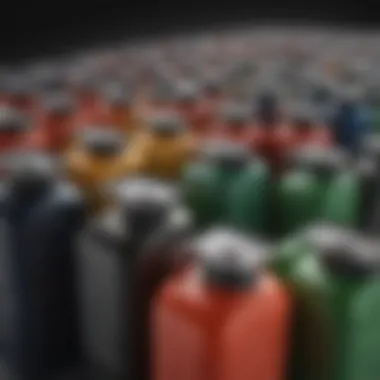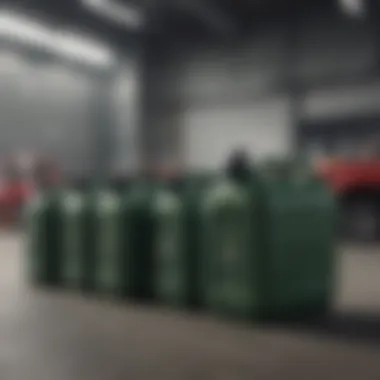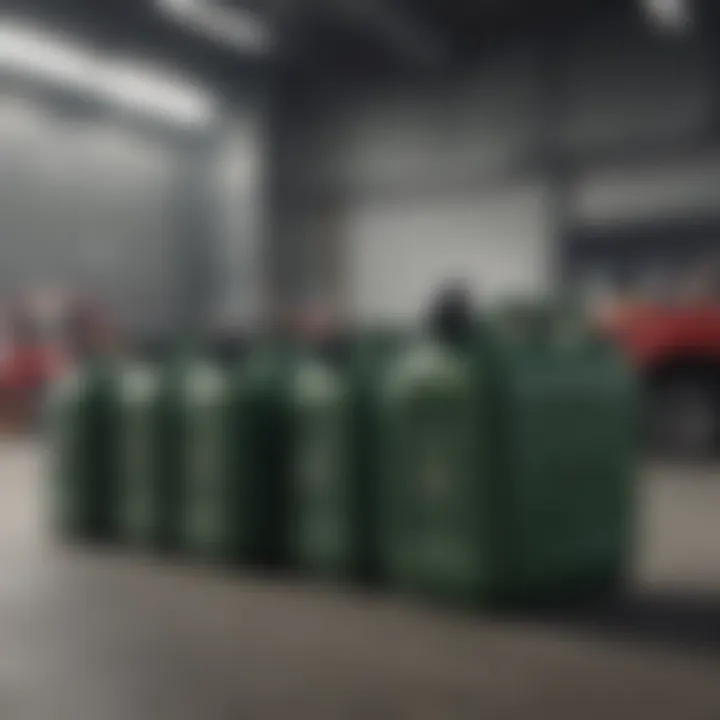The Importance of Spare Gas Cans for Automotive Safety


Intro
In today's rapidly evolving automotive and boating landscapes, the role of spare gas cans cannot be overstated. They serve as a vital resource, contributing to both convenience and safety. With increasing fuel prices and the push for emergency preparedness, understanding how to utilize these tools effectively is essential for enthusiasts and casual users alike.
Spare gas cans come in various forms, designed to cater to distinct needs. From the standard metal types to advanced plastic variants, each offers unique advantages and potential drawbacks. Comprehending these nuances is crucial for making informed decisions and maximizing the utility of these storage solutions.
Moreover, as environmental considerations gain prominence, it is vital to consider the implications of having spare gas cans on hand. They influence how we manage fuel, potentially curbing waste and promoting sustainable practices.
This article aims to provide an in-depth analysis, covering several key themes including the current trends influencing gas can purchases, the latest models available on the market, and crucial safety protocols that should guide any storage practices. Let us begin by examining the Current Trends in this ardent topic.
Preface to Spare Gas Cans
Spare gas cans serve crucial roles in the automotive landscape, offering both practical benefits and contingency measures. Understanding their significance goes beyond merely recognizing them as containers for fuel. These cans are often essential tools for emergency preparedness and fuel management, especially for automotive and boating enthusiasts. As individuals become more reliant on their vehicles and the demands for off-road activities grow, the importance of having a spare gas can at hand cannot be overstated.
A spare gas can emergency situations where a routine refueling may not be possible or when unexpected fuel consumption occurs. These cans provide a safety net that enables users to mitigate risks associated with running out of fuel in remote areas or in adverse weather conditions. By keeping a gas can readily available, one enhances overall vehicle reliability and minimizes potential stress associated with transportation.
Purpose and Functionality
The primary purpose of spare gas cans is straightforward: to hold and store fuel safely and efficiently. However, their functionality extends into several domains. They allow individuals to refuel vehicles when gas station access is limited or non-existent. This is particularly relevant for adventures in less populated regions, where infrastructure may be sparse.
Moreover, modern gas cans are designed with safety in mind. Features such as venting systems and spout designs aim to minimize spills and control pour rates. This functionality is critical in preventing not only environmental damage but also personal injury. Thus, a well-designed gas can is more than a storage container; it is an integral part of responsible fuel management.
Common Scenarios for Use
Several scenarios underscore the significance of using spare gas cans. These include:
- Long Road Trips: For drivers embarking on long journeys through remote areas, it is wise to carry a spare can. Fuel availability can be unpredictable in rural regions, making a gas can an essential companion.
- Boating and Marine Activities: Enthusiasts often use spare gas cans to ensure they have sufficient fuel for their boats, especially during extended outings. Storing additional fuel can prevent trip interruptions and enable users to maximize their experiences on the water.
- Severe Weather Events: During severe weather conditions, gas stations may be closed or fuel supplies may dwindle. Having a spare gas can ensures that one remains mobile during emergencies.
- Recreation Vehicles and ATVs: Off-road vehicles frequently traverse long distances away from traditional fueling stations. Carrying spare fuel provides peace of mind and enhances the experience of outdoor enthusiasts.
Types of Spare Gas Cans
Understanding the various types of spare gas cans is crucial for selecting the right one based on individual needs and safety considerations. Each type has its own characteristics, benefits, and requirements, which can affect functionality and efficiency in various situations.
Material Variations
Plastic Cans
Plastic cans are lightweight and typically easy to handle. They are commonly made from high-density polyethylene, which is resistant to corrosion and often more affordable than metal counterparts. The principal benefit of plastic cans is their resistance to dents and damage, making them a practical choice for everyday use. This durability is especially advantageous during transportation and storage in various environments.
However, the potential downside lies in their durability against certain chemicals and extreme temperatures, which can cause degradation over time. Users should ensure that the fuel stored does not react adversely with the plastic material. Additionally, while plastic cans may not corrode, they can become brittle with age if exposed to sunlight for long periods.
Metal Cans
Metal cans, often constructed from steel or aluminum, offer robust protection for stored fuel. One of their key characteristics is longevity; they tend to outlast plastic under certain storage conditions. Their resistance to punctures or cracks adds to their appeal, particularly in rugged environments.
A distinct feature of metal gas cans is their superior ability to handle high temperatures, which makes them safer in conditions of extreme heat. However, one must also consider weight; metal cans can be heavier and may require more careful handling during transport. Furthermore, without proper care, they are susceptible to rust when exposed to moisture, which can compromise their integrity over time.
Composite Materials
Composite materials have recently emerged as a middle ground between plastic and metal, combining the advantages of both. These cans often utilize a combination of plastic and metal in their construction, leading to enhanced strength and durability. The lightweight nature of plastic is preserved, while the metal components provide added protection against impacts.


The key advantage of composite materials is their improved resistance to environmental factors, including exposure to chemicals and temperature fluctuations. This versatility makes them suitable for both personal and professional uses. However, their cost can be higher compared to traditional materials, which might deter some consumers.
Design Features
Spout Design
The spout design is a critical aspect that directly affects the usability of gas cans. Effective spout designs facilitate smooth pouring and minimize spills. Many modern cans feature a controlled flow spout, which provides precision during refueling. This is particularly important for consumers who aim to avoid environmental contamination as well as wasted fuel.
A unique feature of some spout designs includes a safety lock mechanism that prevents accidental dispensing, thereby making it a favorable choice for safety-conscious users. While convenient, some spout designs can be confusing or difficult to use for those unfamiliar with their operation, potentially leading to frustration.
Capacity Options
Gas cans come in various capacity options, usually ranging from one to five gallons or more. The choice of capacity plays a key role depending on the intended application. For instance, a larger capacity may be beneficial for longer road trips or activities requiring multiple refuels, while smaller options are ideal for general maintenance or emergency use.
However, larger cans can be bulky and may pose a challenge during transport and storage. The convenience of smaller cans lies in their portability, though they may require more frequent refilling, which could be impractical in certain situations.
Safety Features
Safety features are essential in the design of spare gas cans due to the risks associated with fuel storage. Many cans include built-in safety elements such as flame arrestors and pressure relief valves to minimize the risk of fire-related accidents.
A distinctive aspect is the child-resistant caps seen in many modern designs, ensuring secure closure while preventing young children from accessing the contents. These safety measures provide significant peace of mind, especially for families. Nevertheless, it is essential that users familiarize themselves with these safety features, because misuse can lead to dangers, rendering the safety features ineffective.
Safety Considerations
Safety considerations are paramount when discussing spare gas cans. The handling and storage of fuel pose inherent risks, making awareness of proper procedures critical. Understanding these safety measures can significantly reduce accidents and ensure the safe use of spare gas cans.
Handling Procedures
When it comes to handling spare gas cans, there are specific protocols that should be followed to minimize hazards. Here are key guidelines to consider:
- Use Protective Gear: Always wear gloves and safety glasses when handling gasoline. This protects the skin and eyes from potential splashes.
- Ventilation is Crucial: Handle gas cans in well-ventilated areas to avoid inhaling harmful vapors. Good airflow helps to dissipate any fumes that may accumulate.
- Keep Away from Ignition Sources: It is critical to keep gas cans away from open flames, sparks, or any other sources of ignition. Gasoline can ignite easily, leading to dangerous situations.
- Secure the Can Properly: Always ensure that the lid of the gas can is tightened securely before moving it. This helps to prevent spills and leaks that could create a fire hazard.
"Proper handling can prevent accidents and save lives. Always prioritize safety over convenience."
Storage Requirements
Storing spare gas cans safely is equally important. Adhering to best practices for storage can help mitigate risks associated with fuel. Here are some recommendations:
- Store in a Cool and Dry Place: Avoid direct sunlight and heat sources that can raise the temperature of the fuel. An ideal temperature range is between 50°F to 70°F (10°C to 21°C).
- Limit Quantity: Store only the amount of fuel necessary for your needs. Excess fuel increases the risk of accidents and complicates safe storage.
- Secure Location: If possible, store gas cans in a locked area or shed to limit access, especially from children. This reduces the risk of accidents.
- Avoid Basements: Storing gas cans in basements or poorly ventilated areas is not advisable. In case of a leak, vapors can accumulate, creating a serious explosion risk.
In summary, a proper understanding of safety considerations for spare gas cans cannot be understated. Both handling procedures and storage requirements are vital for preventing accidents and ensuring safe usage.
Legislative Aspects
Understanding the legislative framework surrounding spare gas cans is vital for both consumers and manufacturers. These laws are designed to ensure safety, create standards, and regulate the storage and transportation of fuel. Compliance with these regulations not only protects individuals but also helps prevent accidents and environmental hazards associated with improper handling of fuel.
Regulations on Storage and Transport
Regulations regarding the storage and transport of spare gas cans vary by region, but there are common principles that many jurisdictions share. Key elements include:
- Container Standards: Many states specify that gas cans must meet certain material and design standards to be deemed safe for use. For example, the American National Standards Institute (ANSI) provides guidelines on how cans should be constructed to minimize risks.
- Labeling Requirements: Most regions require clearly marked containers that inform users about the contents and associated hazards. Labels often include warnings about flammability and safe handling instructions.
- Quantity Limits: Certain regulations limit the amount of fuel that can be stored in residential settings to prevent potential hazards. This is especially critical in densely populated areas.


Complying with these rules is essential. Failing to adhere to them can result in fines or legal penalties.
State-Specific Laws
Different states have unique laws regarding spare gas cans that reflect local priorities and conditions. For instance:
- California mandates that all gas cans sold must feature a dust-proof spout, significantly reducing the risk of spills during refueling.
- New York enforces strict guidelines concerning the storage of fuel on residential properties, limiting the amount that can be stored at once.
- Texas may have fewer restrictions, but still requires compliance with federal guidelines, focusing on both safety and environmental impact.
Awareness of these state-specific laws is crucial for both consumers and businesses. Ignorance of legal requirements can lead to unintentional violations.
Being informed about the legislative aspects governing spare gas cans not only assures compliance but fosters safer practices in fuel management.
Market Trends
Market trends related to spare gas cans are crucial for understanding evolving consumer needs and the broader impacts on industry standards. The market for spare gas cans has seen significant change in recent years, driven by shifts in consumer preferences, safety and environmental regulations, and technological advancements. As the automotive landscape evolves, so too do the requirements for fuel storage solutions.
Consumer Preferences
Consumer preferences have shifted towards more efficient, durable, and safe gas cans. Users are increasingly looking for products that provide not only functionality but also ease of use. This includes features such as ergonomic designs for gripping and pouring, and safety mechanisms that prevent spills and accidents. Buyers are also valuing products that are made from environmentally friendly materials, aligning with a growing trend of sustainability in consumer choices. The rise of online platforms for purchasing automotive supplies has made it simpler for consumers to compare products based on these preferences.
Key factors influencing consumer preferences include:
- Safety Standards: Regulations have influenced consumer choices, pushing them towards cans that comply with safety norms.
- Material Quality: Consumers prefer gas cans made from high-quality materials that promise longevity and resistance to environmental factors.
- Design and Ergonomics: An increasing number of users favor cans that are comfortable to hold and easy to pour from, making usability a top priority.
Innovations in Gas Can Design
The design of spare gas cans has seen numerous innovations aimed at enhancing user experience and safety. Manufacturers are investing in research and development to create products that not only meet regulatory standards but also resonate with consumer desires for enhanced functionality.
Recent innovations include:
- Spout Technology: New designs feature spill-proof spouts and easy-pour nozzles, reducing the risk of fuel emissions and enhancing precision during refueling. This addresses both safety and environmental concerns.
- Material Advancements: The adoption of composite materials has led to lighter cans that maintain durability. These materials resist corrosion, making them ideal for various climates and uses.
- Smart Gas Cans: Emerging technology has enabled some manufacturers to introduce smart gas cans that integrate sensors to measure fuel levels and temperature, providing users with critical information in real-time.
"Innovation in gas can design reflects not only the needs of consumers but also a commitment to responsible environmental stewardship."
Environmental Considerations
The role of spare gas cans extends beyond mere utility; it has significant implications for the environment. Understanding these considerations is essential when assessing the practicality and necessity of having spare gas cans. In a world increasingly concerned with sustainability and environmental responsibility, the use of gas cans must align with best practices that minimize negative impacts on our ecosystems.
Emissions and Fuel Management
Proper emissions management is crucial when utilizing spare gas cans. Gasoline, as a volatile substance, can release harmful fumes when improperly stored or during transfers. These emissions contribute to air pollution. Hence, it is imperative to choose gas cans that are designed to reduce evaporation losses. Modern cans often come equipped with anti-spill spouts and venting systems that control vapor release.
Moreover, effective fuel management practices help in preserving resources. Regularly checking the condition of gas cans prevents leaks. It is advisable to store gasoline only for necessary periods, as aged fuel can lead to engine performance issues and increased emissions. Adopting a proactive approach helps maintain not just efficiency but also environmental integrity.
Disposal and Recycling
The responsible disposal and recycling of spare gas cans cannot be overlooked. As households and businesses generate waste, the potential for environmental harm increases when materials like plastic and metal are not disposed of correctly. Many areas have guidelines for disposing of fuel containers, thus ensuring that toxic substances do not contaminate landfills or water sources.
Recycling practices should also be part of consumer awareness. While many consumers may overlook the recyclability of metal gas cans, they are indeed recyclable. Plastic cans, on the other hand, must be handled with care due to the potential for residual fuel. By choosing to recycle, consumers contribute to reducing landfill waste and promote a circular economy.
"By managing emissions and ensuring proper disposal, spare gas cans play an active role in environmental stewardship."


In summary, understanding the environmental considerations of spare gas cans is crucial. Implementing effective fuel management can mitigate harmful emissions, while responsible disposal and recycling practices can greatly reduce the ecological footprint. For automotive and boating enthusiasts, this advocacy for the environment integrates seamlessly with the value of spare gas cans.
Using Spare Gas Cans Effectively
Using spare gas cans effectively is vital for automotive enthusiasts and everyday drivers alike. Proper usage not only enhances the convenience of refueling but also plays a crucial role in safety and environmental considerations. This section delves into best practices for refueling and emphasizes the importance of maintenance and care for the longevity of gas cans.
Best Practices for Refueling
When it comes to refueling with spare gas cans, following some essential protocols can ensure safety and efficiency. Here are several best practices to consider:
- Avoid Overfilling: Always leave some space in the gas can to allow for fuel expansion. This prevents spills and minimizes the risk of a fire hazard.
- Use a Funnel: Utilizing a funnel can help in guiding fuel directly into the tank, reducing the chances of spilling.
- Check for Leaks: Before use, inspect the gas can for any signs of wear and tear. If there are cracks or other damages, avoid using the can altogether.
- Refuel in Safe Locations: Choose well-ventilated areas away from open flames or sparks. Avoid refueling in enclosed spaces where gas vapors can accumulate.
- Keep it Upright: Always transport and store gas cans in an upright position to prevent spills.
"Proper handling of spare gas cans not only protects the user but also the environment from gasoline exposure."
Maintenance and Care
Maintaining spare gas cans extends their lifespan and ensures safe usage. Here are some maintenance tips:
- Clean Regularly: Keep gas cans clean from dirt and fuel residues. A clean gas can reduces the risk of contamination, which could harm engine performance.
- Inspect Seals and Caps: Check gaskets for proper sealing. A strong seal prevents gasoline from evaporating and keeps fuel fresh for longer.
- Store Properly: Keep gas cans in a cool, dry place, away from direct sunlight and heat sources. Extreme temperatures can affect the can's integrity.
- Rotate Fuel: If you have older fuel, consider using it rather than letting it sit too long. Gasoline can degrade over time, reducing its effectiveness.
- Follow Manufacturer's Guidelines: Each gas can might come with specific instructions for care and usage. Following these ensures compliance with safety standards.
Using spare gas cans effectively hinges on both strategic refueling practices and diligent maintenance efforts. By adhering to these guidelines, users can navigate the challenges of fuel storage and transportation safely while maximizing the utility of their gas cans.
Alternative Solutions
The exploration of alternative solutions for fuel storage extends the discussion around spare gas cans. While gas cans serve a critical role in many situations, understanding other options can enhance safety and efficiency in fuel management. Alternative solutions often cater to different needs, whether for personal use or for business operations.
Other Fuel Storage Options
When considering fuel storage, several alternatives to traditional gas cans can be effective. Some notable options include:
- Fuel Bladders: Insulated and flexible, fuel bladders can be a practical option for larger fuel storage needs. They are designed to be durable and are beneficial for off-road vehicles and marine applications. Their collapsible nature simplifies transportation and storage when not in use.
- Permanent Fuel Tanks: Vehicles, boats, and equipment often feature built-in tanks made from materials designed to resist fuel degradation. These tanks hold a specific volume of fuel and are generally regulated for safety.
- Portable Fuel Tanks: Unlike spare gas cans, portable tanks can be larger and might come with integrated pumps. Products from brands like Scepter offer options that are suitable for both gas and diesel. These tanks often come with built-in safety features.
- Digital Fuel Management Systems: For businesses that require precision in fuel management, digital solutions can be important. They include inventory tracking systems, notification alerts for low fuel levels, and efficient refilling schedules.
Each of these alternatives carries specific benefits and considerations. For instance, bladders save storage space but may lack the durability of metal cans. Portable tanks offer convenience but may not be practical for all consumers. The best choice often depends on individual needs and context.
Technology Advancements
Technology has transformed the landscape of fuel storage and management. Advances in materials and designs greatly improve safety, efficiency, and user experience. The following developments highlight key progress in the field:
- Smart Monitoring Systems: Some modern fuel storage options are equipped with sensors that monitor levels and leakages in real-time. These systems send alerts to smartphones or computer systems, helping prevent dangerous situations.
- Enhanced Materials: The use of advanced composite materials provides a balance between weight and durability. These materials withstand harsh environments, reducing the risk of damage or leaks.
- Eco-friendly Solutions: Innovations focused on sustainability have led to options like biodegradable tanks or those made from recycled materials. This reflects a growing awareness of environmental impacts associated with fuel storage.
- Automated Refueling Technologies: Some systems now support automated refueling processes for fleets or personal vehicles. This reduces human error and increases efficiency, especially in commercial settings.
Overall, technology's role in improving alternative fuel storage solutions is profound. It not only enhances the user experience but also addresses numerous safety and environmental concerns that gas cans alone cannot manage thoroughly.
Epilogue
In this article, we delve into the multifaceted role of spare gas cans in automotive care and broader applications. Understanding their utility is crucial for both vehicle owners and enthusiasts. The key elements we explored include safety considerations, regulatory frameworks, and environmental implications. Spare gas cans serve as critical tools in emergency situations, as well as for routine maintenance and fuel storage.
Summarizing Key Points
- Purpose and Functionality: Spare gas cans provide a practical solution for fuel storage, whether for a roadside emergency or extended travel. They ensure that fuel is accessible when needed most.
- Types and Materials: Different types of gas cans cater to various needs, with materials ranging from plastic to metal. Each type has its benefits and drawbacks, such as weight, durability, and safety features.
- Safety Protocols: Proper usage and handling of gas cans is paramount. The article emphasized essential safety measures, which include understanding how to store and transport these cans legally and securely.
- Market Trends and Innovations: The landscape of spare gas can design is evolving. Innovations in safety features and materials directly impact consumer choice and preferences.
- Environmental Considerations: Knowing how to dispose of or recycle gas cans can help reduce environmental footprints and align with sustainable practices.
Final Thoughts on Spare Gas Cans
In summary, spare gas cans are not just practical items; they represent a broader commitment to responsible fuel management and safety. The importance of selecting the right type of can, adhering to safety guidelines, and understanding legal regulations cannot be overstated. Automative enthusiasts should view these tools as an essential aspect of preparedness, ensuring smooth operations during journeys or emergencies.
"Investing in a quality spare gas can is an investment in peace of mind and operational efficiency."
By incorporating these elements into the discussion, we aim to equip consumers and enthusiasts with the knowledge needed to utilize spare gas cans effectively and responsibly.







